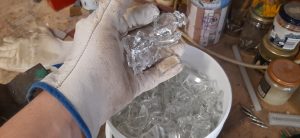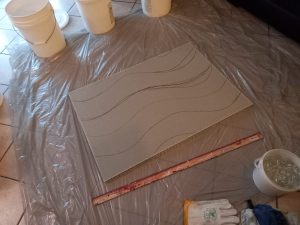by Giorgio Carera Quarena, Year II of the postgraduate course in Artistic decoration (A.Y. 2021/22); and Mirko Ramera, Year III of New technologies (A.Y. 2021/22)

My name is Giorgio Carera Quarena, and I am a decorative artist who loves ancient art, although I do not specifically refer to classic Greek models. In my research as an artist I try to combine ancient, medieval and modern art with a contemporary vision. My aim is to bring knowledge, traditions and techniques of the past to what I believe to be an exceedingly individualistic and fluid approach. Personally, I also refer to Carl Gustave Jung’s work and I would like to express a collective unconscious in shapes and colors used in decorations through time.
– Giorgio C. Quarena

My name is Mirko and I am mainly involved in audiovisuals. I develop video and sound products, trying to bring the two together.
– Mirko Ramera
My work is often intended to enhance an existing work of art recreating a soundscape or a sound carpet close to the emotional sphere. It is linked to the artists’ ideas underpinning the work, bringing out those elements. This is the case for Vine Cards, suggested for Ca’ del Bosco.
The concept behind Vine cards
by Giorgio Carera Quarena
I was attracted to businesses like Cà del Bosco after a tour of the cellars where they wisely mix innovation and respect for tradition. I prepared a decorative panel combining Figurative Art and winemaking, which is what my client wanted. I used mosaics, a technique developed 5000 years ago – millennia old, just like winemaking – but applied it with contemporary eyes. For my Vine Cards I used stones to portray the moraine, the distinctive soil of Franciacorta: millions of years ago there was a glacier that withdrew leaving a large amount of materials in its wake. In time, materials were covered by soil giving rise to moraines. The gravel from these formations has been used for centuries in building houses and the dry stone walls surrounding the vineyards. Moreover moraine is rich in minerals, essential for good vine growth. I gathered stones in the Cà del Bosco vineyards so that my work of art and the vineyard are one. I also included glass from the bottles used for their wine made of recycled glass, in line with the winery’s firm environmental commitment.
Stones and glass used in my artwork jet out a little from the substrate: they are positioned in the mortar and the parts sticking out are neither sharp not pointed, so there is no danger for visitors.
Vine Cards is an iconographic piece, despite being abstract: the glass shards are vine rows and the stones are the moraine. The transparent pieces of glass positioned in the yellow mortar stand for the vines with their reflexes and sparkle. It points to the fact that Cà del Bosco enriches the area, as the color yellow both recalls the contents of the bottles and their renowned sparkling wine, and the color of gold, the symbol of what is precious, of the sun, a color that stands for warmth and vital energy. My work of art plays on alternating the preciousness of glass, or the rough stones: the two elements alternate and the balance between them generates life and beauty. Since it is a mosaic, that is a timeless, lasting form of art, it symbolizes the fact that we want to take these ideas and the love for this land towards the infinite, making them eternal.
Multimedia contribution Connected Life
by Mirko Ramera
The idea behind the composition created is a metaphor that represents the sound of earth, of nature, of human being and of his contribution to the development of this territory. In the specific case tells of a person who cultivates his own vineyard, giving life to poor soil.
At the beginning of the composition Connected Life, we can perceive a strong wind that spreads over the desolate land, devoid of any sound beauty, then noises take over the composition: some steps, the earth being moved, tools, which represent a person who cultivates the land extrapolating from it the resulting fruits. The fruit is represented through a very calm and serene sound.
Subsequently the person returns and gives life to a more passionate and marked sound; finally, the soundscape dominates both the sound of wind and of that poor landscape.
Work in progress for realizing Vine cards









